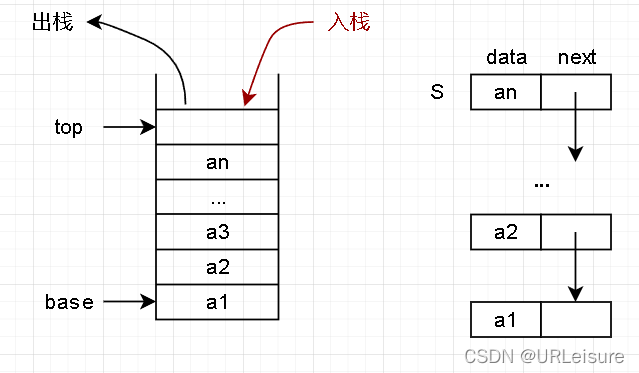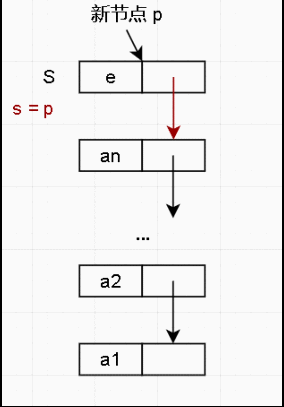【数据结构】栈(stack)-栈链(动态图解、c++、java)
文章目录
- 栈链概述(图解)
- 链栈的基本操作
-
- 1.初始化
- 2.入栈
- 3.出栈
- 4.取栈顶
- 完整代码
- 总结
GitHub同步更新(已分类):Data_Structure_And_Algorithm-Review
公众号:URLeisure 的复习仓库
公众号二维码见文末
以下是本篇文章正文内容,下面案例可供参考。
栈链概述(图解)
-
顺序栈是分配一段连续的空间,需要两个指针,base指向栈底,top指向栈顶。
-
链栈每个节点的地址是不连续的,只需要一个栈顶指针即可。
-
从图中可以看出,链栈的每个节点都包含两个域:数据域和指针域。
链栈的基本操作
- 链栈是操作受限单链表
- 只能在头部进行插入、删除、取值等操作;
- 不能在中间和尾部操作进行任何操作。
- 因此,可以按单链表的方法定义链栈的节点。
首先定义一个结构体(内部类),包含一个数据域和一个指针域。
c++代码如下(示例):
typedef struct SNode {
int data;//数据域
SNode *next;//指针域
} *LinkStack;
java代码如下(示例):
public static class SNode {
int data;
SNode next;
}
1.初始化
- 初始化一个空的链栈是不需要头结点的,因此只需要让栈顶指针为空即可。
c++代码如下(示例):
void Init(LinkStack &S) {
S = NULL;
}
java代码如下(示例):
public static void init(SNode s){
s = new SNode();
}
2.入栈
- 入栈是将新元素节点压入栈顶。
- 链栈中第一个节点为栈顶,因此将新元素插入到第一个节点的前面;
- 然后修改栈顶指针指向新节点即可。
c++代码如下(示例):
void Push(LinkStack &S, int e){
LinkStack p = new SNode;
p->data = e;
p->next = S;//新元素的下个地址是老的栈顶
S = p;//栈顶上移
}
java代码如下(示例):
public static void push(int e) {
SNode p = new SNode();
p.data = e;
p.next = s;
s = p;
}
- 将新节点的指针域指向栈中最上面的指针; p->next = s
- 讲新节点置为栈顶。 s = p
3.出栈
- 出栈是把栈顶元素删除。
- 让栈顶指针指向下一个节点; s = s->next
- 然后释放该节点空间(c++)。
c++代码如下(示例):
bool Pop(LinkStack &S, int &e){
if(S == NULL){//栈空
return false;
}
LinkStack p = S;//临时节点
S = p->next;//栈顶下移
e = p->data;//记录出栈元素
delete p;//释放空间
return true;
}
java代码如下(示例):
public static int pop() {
if (s == null) {
return -1;
}
SNode p = s;
s = s.next;
return p.data;
}
4.取栈顶
- 取栈顶和出栈不同。
- 取栈顶元素只是吧栈顶元素复制一份,栈顶指针未移动,栈内元素个数未变。
c++代码如下(示例):
int GetTop(LinkStack S){
if(S == NULL){
return -1;
}
return S->data;
}
java代码如下(示例):
public static int getTop() {
if (s == null) {
return -1;
}
return s.data;
}
完整代码
c++代码如下(示例):
#includejava代码如下(示例):
public class A {
public static class SNode {
int data;
SNode next;
}
private static SNode s;
public static void init(SNode s){
s = new SNode();
}
public static void push(int e) {
SNode p = new SNode();
p.data = e;
p.next = s;
s = p;
}
public static int pop() {
if (s == null) {
return -1;
}
SNode p = s;
s = s.next;
return p.data;
}
public static int getTop() {
if (s == null) {
return -1;
}
return s.data;
}
public static void main(String[] args) {
init(s);
System.out.println("链栈初始化成功!");
push(5);
push(4);
push(3);
push(2);
push(1);
System.out.println("创建成功");
System.out.println("元素依次出栈");
while (s != null) {
System.out.print(getTop() + " ");
pop();
}
System.out.println();
}
}
总结
- 顺序栈和链栈的基本操作都只需要常数时间,所以在时间效率 上难分伯仲。
- 在空间效率 方面,顺序栈需要预先分配固定长度的空间,有可能造成空间的浪费或溢出。
- 链栈每次只分配一个节点,除非没有内存,否则不会出现溢出,但是每个节点需要一个指针域,结构性开销增加。
- 因此,如果元素个数变化较大,可以采用链栈;反之,可以采用顺序栈。
在实际应用中,顺序栈比链栈应用更广泛。
关注公众号,感受不同的阅读体验
![]()
下期预告: 循环队列

